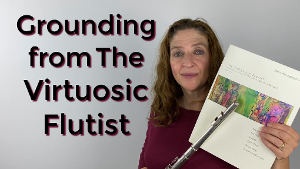Grounding. That is an interesting word when referring to flute playing. So, what does it mean? I think it refers to all that resounds when you play. It is all about the things needed to reach depth of tone and resonance.
For this blog (and Flute Tip) I will reference a book titled The Virtuosic Flutist which was written by a good friend of mine named Nina Assimakopoulos. You can find her on Instagram under her name and The Virtuosic Flutist. This If you don’t have it in your library go get it. It’s a great book to have in your repertoire. The technical aspects of flute playing that she describes, vibrato and breathing and different things about parts of your body and how you use them, are really very well thought out. There is a lot of reading material and then there is the exercises that you then apply what you read. Also included is real musical examples and exercises to apply the skills you are learning.
Let’s talk about the first aspect of grounding mentioned in the book and that is your stance or how you are connected to the ground. Do you have a nice, solid playing stance that allows you to be flexible, be relaxed, but also solidly in place? I have seen many people play for me with a bad playing position. They are uncomfortable and unsteady. Oftentimes their feet are too close together. This is not a solid stance from which to begin practice. Consider that our feet should be a shoulder width apart in a comfortable position, so that you are standing straight and tall when you breathe. Your breath can come from your toes and go directly up into your sinuses. You should feel that you are a solid rock right here as you stand. There’s nothing that’s going to tip you over or get you off balance. You’re right there.
Another aspect of grounding is what Nina refers to as breath energy, or the process of how you’re taking that breath. Are you opening up your sinus cavity? Are you opening up your mouth? Are you opening your throat in? And are you filling up your stomach and ribcage? Does the playing position allow you to fill up from the feet and then create air pressure or support which is so necessary to have the sound that we’re all looking for? Nina goes into a lot of detail about your vocal tract, the different parts of your throat and your mouth and how it all works together. It is interesting and helpful so please read her book!
Another important aspect of grounding is your finger engagement. Do you keep your fingers right over their keys? Are they light? This is something that I find very important in my playing and teaching. A lot of students miss the importance of a light touch on the keys. I see so many times fingers that are not just on their keys but fingers that hang onto the flute as if on a branch to keep from falling. Those fingers are going to be very stressed and tight. Besides the light finger touch we need to not let fingers fly up after being pressed or not being used. We all can see when students’ fingers fly up. But in reality, you should keep them low on their keys with the pad of your finger resting on the hole. That’s the best most relaxed position to be in. Make sure when you use those fingers, they are also light! When I play, my fingers are completely relaxed. They’re loose, and can move with agility. Tight fingers are going to create tight hands and arms and a tight throat, and affect your tone.
It’s all connected!
If you are having trouble with that, I would use the exercise that I learned way back in my youth which is to play Taffanel and Gaubert’s 17 Grand Exercises for the Flute exercise 1 or 2. Because the exercise is in scales you don’t have to think about it and can work on your fingers. Learn to keep them light and not use any pressure at all. Nothing. Then your fingers will never ever get tired.
On to breathing. When you take your breath, do you take a real one? In other words, do you fill up your stomach and ribs and completely fill up from bottom to top. If you don’t learn to fill up all the way then you need to work at stopping and breathing. Take the length of time you need to take that breath, and then come back in. That’s the best way to learn how to breathe properly; come to a full stop, come back in, and resume playing.
When you take your breath, you need to open up the mouth cavity. It is very important that your mouth is open with your teeth being a finger and a half apart. This openness allows for the throat to stay open and the sound to come out. It makes a world of difference in your tone when you open up. It is immediate gratification!
Now, the fun part of this is the exercise. Since you’ve learned to breath properly, open your mouth cavity, open throat, your stance is good, and your fingers are close and light, you have now earned the right to practice this grounding exercise. You can listen to the exercise in the video to know what it sounds like, but basically it is a version of a scale with no skipping around. To play each note Nina says to use a stomach, “Huh” as you play, accenting your different notes. Now, after having practiced this for a bit, I will tell you that if you work on this, you’re going to have great abs. It’s a strong exercise for your abdominal muscles and playing it for a little bit can get tiring in the stomach muscle area. In the video I demonstrate how to play the exercise with the stomach “Huh.”
Breathe anywhere that you want. Keep your fingers close, and then be aware of what you are playing. Think about it, don’t just play it. Think about what you’re doing, your stance, your fingers, your throat, your mouth cavity and your stomach. She then advocates that you play these in all major and minor keys.
The exercise is about two-thirds of a page but I can tell you that just after a line or two, my abdominals are a wee bit tired. It’s a lot of work! But I hear it just working on my tone right now making my tone get bigger and fatter and more resonant.
I love this exercise. If you haven’t gotten Nina’s book yet, it’s available both in a digital copy and in hard copy so wherever you are in the world you can get a copy. You can do that either from Nina’s website or you can get it from any online retailer, such as Flute World.
This should be in your arsenal of technique books. There are ways of thinking about flute technique that aren’t your everyday traditional way. So, get this book, work on this exercise, do your sit-ups, you’ll be happy, and you’ll hear your tone get better and better as you do it.
Have Fun!
DoctorFlute
Watch me demonstrate this:
Grounding from Nina Assimakopoulos book The Virtuosic Flutist FluteTips 112

Tone Color from Nina Assimakopoulos book The Virtuosic Flutist FluteTips 107

